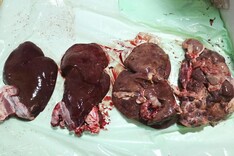Reports from vets and factories indicate that there are some issues starting to emerge on farms due to liver fluke.
The mild weather in late 2021 took some of the focus away from treatment programmes, with lambs in particular on some farms slipping under the radar.
The issues are very much linked to location, with farms on the western seaboard and northern half of the country worst affected.
There have also been issues reported where lambs have been purchased out of these areas for finishing on farms in the east.
This has given rise to a slight increase in liver fluke condemnations, as well as an increase in cases of mortality due to liver fluke.
Tell-tale signs
The treatment options at this stage of the year are mainly focused on treating chronic liver fluke, with mature and immature liver fluke parasites doing the most damage.
The tell-tale signs of chronic disease are loss of condition, anaemia leading to paleness around the eyes, a dull or lethargic reaction from sheep and bottle jaw or swelling under the jaw region.
These symptoms may be masked somewhat in lambs being finished intensively.
Faecal egg counts can be strategically used in helping to determine the presence of mature liver fluke parasites
Regular weight monitoring will help to identify potential problems, with liver fluke infection having the potential to greatly depress lamb performance.
This can have significant financial repercussions, especially in an era of rising finishing costs.
Faecal egg counts can be strategically used in helping to determine the presence of mature liver fluke parasites. A useful indicator is following up on the health status of livers from sheep drafted for slaughter, and it goes without saying that any cases of mortality should be investigated.
Treatment options
The options available for treating finishing lambs are always tricky due to the longer withdrawal periods of flukicides. These vary from 42 days to 66 days for the main flukicide-only products.
There are some combination fluke and wormer products that treat only mature liver fluke, with these products possessing a shorter withdrawal period.
However, they should only be used where there is no alternative, as the use of wormers where there is no demonstrated need will only serve to increase the rate of anthelmintic resistance developing.
Animals such as ewe lamb replacements should receive a flukicide-only product, with products selected that treat immature and mature liver fluke.
Ewes which are housed offer the potential of being able to broaden the normal selection of products available
Where ewes are outwintered, then treatment should take place on farms with known liver fluke problems in January/early February and again in April.
Ewes which are housed offer the potential of being able to broaden the normal selection of products available and use a product which targets only mature liver fluke parasites.
For this option, sheep need to be housed for at least eight to nine weeks, or shorter where a product is used that treats immature and mature liver fluke.
The use of products with the active ingredient oxyclozanide should also be used sparingly, as these are necessary where it is identified that treatment is required for rumen fluke.
Again, this should be on the basis of a demonstrated need.
Note also that there is a new product available on the Irish market, Fascionix 34%, which is essentially an exact replacement for Trodax.







 This is a subscriber-only article
This is a subscriber-only article










SHARING OPTIONS: